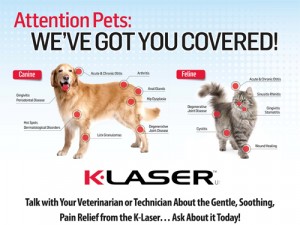
As we enter the colder months, arthritis becomes more significant for our dogs and cats. We offer many options to help decrease the discomfort of arthritis in our patients. Along with medications, there are some natural ways to help your pets with their arthritis pain. Supplements, essential oils and laser therapy are some great alternatives to medication.
NSAIDS (non steroidal anti-inflammatories)
NSAIDS are a cornerstone of arthritis pain management for our dogs that can tolerate them. They help to decrease inflammation, prevent further damage to cartilage and decrease pain significantly. There is a risk of stomach upset, as well as worsening of liver or kidney problems, so proper dosing and monitoring is important. NSAIDS can be used in cats, but are less well tolerated by our senior cats and are less likely used for chronic pain management in cats.
Opioids (narcotics)
We use severe narcotic pain medications in our patients to keep them more comfortable. Tramadol is often used in dogs to help decrease pain, increase mobility and can be used with NSAIDS as well.
Supplements
Welactin and coconut oil are great sources of omega 3 fatty acids. Omega 3 fatty acids have been shown to decrease inflammation in joints and can help decrease arthritis damage to remaining cartilage.
Mobiflex, dasquin advanced and joint health chews are other natural ways to help keep your pets mobility as long as possible.
Essential Oils
Available in blends for both dogs and cats to be used topically. Combination of frankincense, lemongrass, lavender, basil, wintergreen, camphor, peppermint, ylang ylang, helichrysum, blue tansy, blue chamomile and osmanthus. Oils can be used alone or in combination with the other treatment options available.
Acupuncture
Acupuncture can be a great way to help your pet out with arthritis pain. However, if can be difficult to find a good pet acupuncturist close by.
LASER THERAPY FOR YOUR PET
What is Laser Therapy?
Laser Therapy, or “photobiomodulation”, is the use of specific wavelengths of light (red and near-infrared) to create therapeutic effects. These effects include improved healing time, pain reduction, increased circulation and decreased swelling. Laser Therapy has been widely utilized in Europe by physical therapists, nurses and doctors as far back as the 1970’s. Now, after FDA clearance in 2002, Laser Therapy is being used extensively in the United States.
FAQ:
Does it hurt? What does a treatment feel like? There is little or no sensation during treatment. Occasionally the patient feels mild, soothing warmth, or tingling. Areas of pain or inflammation may be sensitive briefly before pain reduction.
Are there any side effects or associated risks? During more than twenty years of use by healthcare providers all over the world, very few side effects have ever been reported. Occasionally some old injuries or pain syndromes may feel aggravated for a few days, as the healing response is more active after treatment.
How long does each treatment take? The typical treatment time is 3 to 8 minutes depending on the size of the area being treated.
How often should a patient be treated? Acute conditions may be treated daily, particularly if they are accompanied by significant pain. More chronic problems respond better when treatments are received 2 to 3 times a week, tapering to once every week or two as improvement is seen.
How many treatments does it take? This depends on the nature of the condition being treated. For some acute conditions 1-2 treatments may be sufficient. Those of a more chronic nature may require 5 to 8 (or more) treatments. Some conditions may require ongoing periodic care to control pain.
How long before the results are felt? Your pet may feel improvement in their condition (usually pain reduction) after the first treatment. Sometimes they will not feel improvement for a number of treatments. This does not mean that nothing is happening. Each treatment is cumulative and results are often felt after 3 or 4 sessions.
Here is a list of conditions that Veterinarians have successfully treated with the K-Laser.
- Rhinits, sinusitis
- Gingivitis, stomatitis and tooth extractions
- Rodent ulcers and feline acne
- Acute and chronic otitis
- Post-surgical
- Cervical and lumbar intervertebral disc disease
- Cystitis
- Feline asthma
- Bursitis and tendonitis
- Lick granulomas
- Pododermatitis
- Arthritis
- Fractures
- Sprains and strains
- Snake bites and bug/spider bites
- Hip dysplasia
- Pyotraumatic dermatitis (hot spots)
- Inflammatory bowel disease
- Dermatomyositis
- Trauma
- Anal saculitis
- Tail fractures
- Rehabilitation
- Acupuncture
Some conditions will improve with one or two K-Laser Treatments, such as post-surgery. Other conditions may require a series of visits over a few weeks. Examples would include lick granulomas, otitis and trauma. And some chronic conditions may require regular maintenance K-Laser treatments, such as arthritis and disc disease. Your Veterinarian will recommend a K-Laser treatment plan that best fits your pets condition.
Has effectiveness been demonstrated scientifically?
Yes. There are thousands of published studies demonstrating the clinical effectiveness of Laser Therapy. Among these, there are more than one hundred rigorously controlled, scientific studies that document the effectiveness of Laser Therapy for many clinical conditions.
Cellular Effects of Laser Therapy
During Laser Therapy the infrared laser light interacts with tissues at the cellular level, and metabolic activity increases within the cell, improving the transport of nutrients across the cell membrane. This initiates the increased production of cellular energy (ATP) that leads to a cascade of beneficial effects, increasing cellular function and health.
Laser Therapeutic Effects
During each painless treatment, laser energy increases circulation, drawing water, oxygen, and nutrients to the damaged area. This creates an optimal healing environment that reduces inflammation, swelling, muscle spasms, stiffness, and pain. As the injured area returns to normal, function is restored and pain is relieved.
What is a Class 4 therapy laser?
Lasers are classified according to their output power. A Class 4 laser has more than 500 milliwatts of power. Higher power means it can deliver more energy per unit of time – which means your Veterinarian can treat a very large area on your pet in just a few minutes.
In the blood capillaries, red blood cells pass through in single file. Laser therapy helps to increase blood flow. Red blood cells carry molecules of oxygen to the tissues. Laser therapy also helps the red blood cells deliver the oxygen molecules directly to the affected tissues.
Finally, laser therapy stimulates an enzyme in the mitochondria of the cells. This processes the oxygen more quickly, and more energy (also known as adenosine triphosphate, or ATP) is produced in the cell.
The end result is healing that is faster and better quality.

